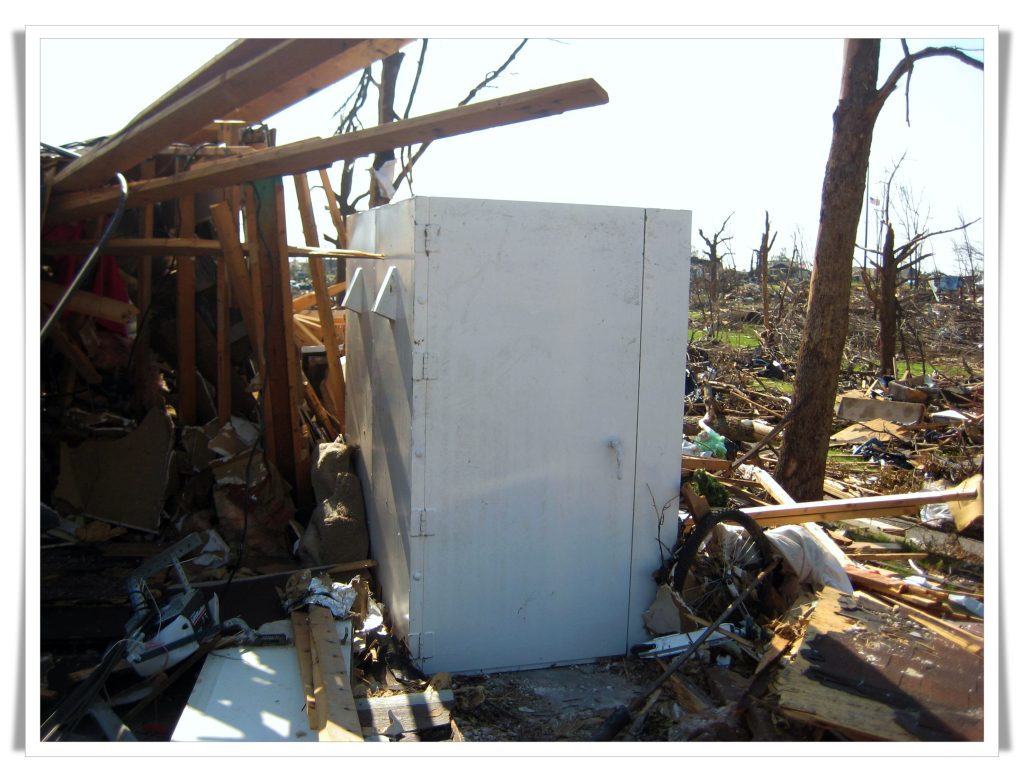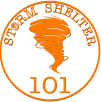Don’t Let Storm Shelter Myths Put Your Family at Risk
For many homeowners, the decision to invest in a storm shelter comes with questions and doubts. You may wonder whether an above-ground shelter can truly withstand a tornado, or whether an underground garage shelter could trap you after a storm. Unfortunately, myths and misinformation often cloud the decision-making process.
The truth is, modern storm shelters that meet FEMA standards and ICC 500 guidelines are carefully designed and manufactured to save lives. By separating myth from fact, homeowners can feel confident that a properly installed storm shelter is one of the safest places to be during severe weather.
Myth 1: Above-Ground Storm Shelters Aren’t Safe
One of the common myths that people have is that above-ground storm shelters can be lifted, toppled, or destroyed by a tornado. People often picture lightweight structures being tossed like sheds or mobile homes, which is far from reality.
The Facts:
- Built to FEMA Standards and ICC 500 Guidelines: Above-ground shelters manufactured and installed to FEMA P-361 and ICC 500 standards are tested against extreme wind and impact debris equivalent to an EF5 tornado.
- Anchoring Is Key: These shelters are not freestanding structures. They are anchored to a concrete slab that is 4-inches or thicker using bolts with a high shear strength. This prevents uplift or sliding. Proper anchoring makes them as secure as being underground.
- Proven in Real Tornadoes: Time after time, storm surveys show above-ground safe rooms standing intact in neighborhoods where everything else was leveled. Families emerge unharmed because the shelter is designed to handle forces far beyond ordinary construction.

Bottom Line: Above-ground shelters are not second-class options, and there is no evidence to suggest that an above-ground storm shelter is less protective than its underground counterpart if built to FEMA guidelines and ICC 500 standards. When installed correctly, they offer the same level of protection as underground shelters and are particularly valuable for families with mobility challenges, since they eliminate stairs or ladders. I wrote an article entitled “Is an Above-Ground Storm Shelter Really Safe?” that covers this topic in much greater detail.
Myth 2: Underground Garage Shelters Will Trap You
Another fear is that an underground garage shelters could trap occupants if a tornado causes debris to block the garage door or collapse the house overhead.
The Facts:
- Multiple Exits: Most modern garage shelters are designed with multiple escape routes. This often includes reinforced lids that can be opened from the inside, emergency hatch systems, or panels that can be removed with basic tools.
- Emergency Preparedness: It’s recommended to keep tools like a jack, crowbar, or even a car jack inside the shelter to assist with pushing away debris if needed. Many manufacturers include these items as part of their installation packages.
- Low Probability of Entrapment: While debris can accumulate, the actual likelihood of being trapped without a way out is very low, especially if you prepare with emergency equipment.
Bottom Line: The risk of being trapped is largely a myth when using a well-designed garage shelter. And when weighed against the risk of staying in an unprotected home during a tornado, the shelter is by far the safer choice.
Myth 3: Below-Ground Yard Shelters Flood Easily
For below-ground shelters installed in a yard or near the home, one of the biggest homeowner concerns is flooding. Some assume that these shelters will become water-filled pits, unusable during a storm.
The Facts:
- Drainage Systems: Reputable installers incorporate drainage, sealants, or sump pumps to address water infiltration. While minor moisture can occur, flooding to the point of unusability is rare when shelters are properly installed.
- Placement Matters: Locating a shelter in a well-drained area of the yard, slightly elevated if possible, reduces the chance of water pooling. Avoiding areas with high groundwater levels is part of good planning.
- Regular Maintenance: Checking seals, keeping the entry clear, and monitoring for cracks ensures your below-ground shelter remains dry and secure year after year.
Bottom Line: Flooding is preventable with proper installation and maintenance. A quality below-ground shelter offers dependable protection without the risk of becoming a water hazard. Obviously, below-ground shelters are not a fit for all homes, such as if you live in a flood-prone area.
Myth 4: Storm Shelters Are Dark, Cramped, and Unsafe
Pop culture and rumors often paint storm shelters as terrifying, coffin-like spaces where families sit in fear. This misconception can discourage homeowners from investing in life-saving protection.
The Facts:
- Modern Comforts: Many shelters now feature ventilation systems (above the ventilation required by FEMA), LED lighting, seating, and room for supplies. They are designed for short-term use, usually just 30 minutes to an hour during a storm. Our storm shelter has LED lighting that runs off 110v electricity and then off batteries (with a power inverter) if the electricity goes out. It also has a mobile A/C unit, battery powered fans, and even a television that runs off both electricity and the backup battery/inverter. The TV is connected to an antenna in our attic so we can watch local channels without the need for cable or Internet access.
- Sizing Options: Shelters come in a range of capacities, from 1-2 people to 20 or more. Families can choose a size that meets their needs and avoids crowding.
- Safety First: Shelters are engineered to eliminate risks like electrocution (thanks to the Faraday Cage Effect in steel models) and to provide a safe environment even during direct tornado impacts.
Bottom Line: Storm shelters are not dungeons. They are safe, practical, and increasingly comfortable environments designed for short stays during severe weather.
Myth 5: Above-Ground Shelters Can’t Handle Flying Debris
People sometimes assume that above-ground shelters will be pierced by lumber, metal, or other tornado debris traveling at high speeds.
The Facts:
- Impact Testing: To meet FEMA and ICC standards, shelters undergo rigorous tests that simulate tornado debris. Certified shelters must withstand these impacts without penetration.
- Real-World Proof: After events like the 2013 Moore, Oklahoma tornado, above-ground shelters were studied and found to be intact even as the homes were destroyed.
Bottom Line: Above-ground storm shelters are engineered to withstand exactly what people fear most: flying debris. They’re tested for the worst-case EF5 scenario.
Myth 6: Underground Shelters Are Always Better
Some homeowners believe that “being underground” is automatically safer. While underground shelters are excellent, assuming they are always superior overlooks other critical factors.
The Facts:
- Accessibility Matters: Underground shelters can be difficult for elderly family members, children, or people with disabilities to enter quickly.
- Equal Standards: Both underground and above-ground shelters need to meet FEMA and ICC 500 standards. Safety depends on design and installation, not simply being underground.
- Local Conditions: In areas with high water tables, rocky soil, or flood-prone land, an above-ground shelter may actually be the safer and more practical choice.
Bottom Line: Safety is not determined by “above” or “below.” Both options, when engineered and manufactured to FEMA and ICC standards, offer life-saving protection. The right choice depends on your family’s needs and your property’s conditions.
Myth 7: Storm Shelters Are Too Expensive to Justify
Finally, some homeowners fear that shelters are luxury items only for the wealthy, putting safety out of reach.
The Facts:
- Wide Price Ranges: Depending on type and size, shelters typically start at a few thousand dollars. Many manufacturers or sellers work with financing options to make them affordable.
- Value of Life: A shelter isn’t just a purchase. It’s an investment in safety. The peace of mind knowing your family has a safe place to go during a severe weather outbreak is priceless.
Bottom Line: Storm shelters are more accessible than most people realize. With financing, rebates, and flexible designs, nearly every family can find an option that fits.
Final Thoughts: Replace Fear With Confidence
When it comes to protecting your family during tornado season, misinformation should never be the reason you hesitate. Above-ground, below-ground, and underground garage shelters all provide life-saving protection when correctly designed, built, and installed. I wrote another article that looks at the pros and cons of above-ground, underground garage shelters, and underground shelters installed in the yard. You can find that article here.
The real danger lies not in choosing the “wrong” type of shelter, but in having no shelter at all.
Investing in a storm shelter means investing in peace of mind. Whether you step into an above-ground safe room, a backyard underground shelter, or a garage-installed unit, you are choosing safety over fear. When the next storm comes, you’ll know your family has the safest place possible to ride it out.
What other myths or misconceptions do you hear about storm shelters? Comment below or contact me directly to discuss.
